One of the most striking and admired structures throughout the history of the City of London is its medieval inhabited stone bridge. Bridges with houses were relatively common in medieval Europe; examples include Bath’s Pulteney Bridge, which is still open for business. However, the old London Bridge, aka the Bridge, as it was commonly known, was the most populous of them all. It is calculated that its 140 houses housed 800 people in the fourteenth century, and the Bridge’s population averaged 500.
 Detail of Old London Bridge on 1632 oil painting View of London Bridge by Claude de Jongh. Photo Credit: ©Public Domain via Wikimedia Commons.
Detail of Old London Bridge on 1632 oil painting View of London Bridge by Claude de Jongh. Photo Credit: ©Public Domain via Wikimedia Commons.
Old London Bridge, aka The Bridge
Throughout its 620 years of existence, the Bridge’s buildings were periodically updated, and traders responded to social changes. It was a feature of London life and often used as a ceremonial processional route. The Bridge was also witness to darker chapters in London’s history, such as its storming during the Cade rebellion in 1450 and Fauconberg’s rebellion in 1471. It survived two Great Fires in 1666 and 1725, which destroyed houses on the north and south ends of the Bridge.
Despite these cataclysmic events, the Bridge’s size and longevity were a testament to its engineering. It was built between 1176 and 1209, about 150 feet east of the current London Bridge. Clergyman Peter of Colechurch, who had worked on the previous wooden London bridge, is commonly referred to as its builder, but it has been suggested he was more of a fundraiser for it. This was between 1202 to 1205 when he died. Isembert of Saintes, the builder of the bridge in La Rochelle in France, was charged by King John in 1202 to complete the Bridge project in lieu of building houses on it. Records are scant, but the Bridge proved to be a sturdy structure.
Although wider and shallower, the late twelfth-century River Thames was still a mighty beast to tame. Coffer dams – enclosures to exclude water from a riverbed – were not invented until the nineteenth century. The traditional building method in medieval London, like the one used for the laying of Venice in the Venetian Lagoon, was the driving of wooden piles into the river bed at low tide, creating watertight enclosures which would then be filled with rubble. These would form the bases of the nineteen piers called starlings. When complete, the Bridge was 926 feet long.
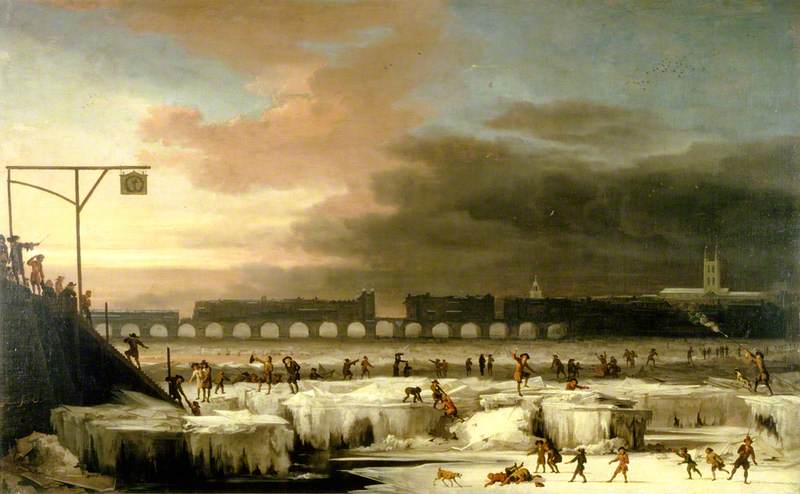 Painting of The Frozen Thames, Looking Eastwards towards Old London Bridge by Abraham Hondius. Photo Credit: © Public Domain via Wikimedia Commons.
Painting of The Frozen Thames, Looking Eastwards towards Old London Bridge by Abraham Hondius. Photo Credit: © Public Domain via Wikimedia Commons.
Design of the Old London Bridge
The old London Bridge was not straight, with slight kinks between its three sections. The piers were irregularly spaced, perhaps a reflection of the unevenness of the river bed, and they varied in width and angle in relation to the roadway. The middle pier, used to house the chapel, was considerably larger than the rest. Other stone structures included the Stone Gate on the second pier on the south section and the Drawbridge Tower, which separated the south and middle sections.
Such a large bridge inevitably restricts the flow of the river, creating a dam effect with a difference in water level of up to five feet, depending on the direction of the tide (ebb going out; flood coming in). This accelerated the flow of water under the Bridge which, besides being dangerous for those ‘shooting the bridge’ in their boats, constantly scoured the Bridge’s foundations, which in turn required constant maintenance. More than once, erosion led to collapses, with five piers crashing down with their houses in 1281 and two arches in 1437.
It is clear from the size of its piers and the narrowness of the arches that the Bridge was designed with the intention of building houses above it. The leasing of these was the primary source of income raised by a dependent body of the City of London called Bridge House, which had premises in Southwark. Other sources of revenue included tolls from carts and boats as well as rentals of premises off the Bridge. The flow of traffic was so important that work was carried out at night.
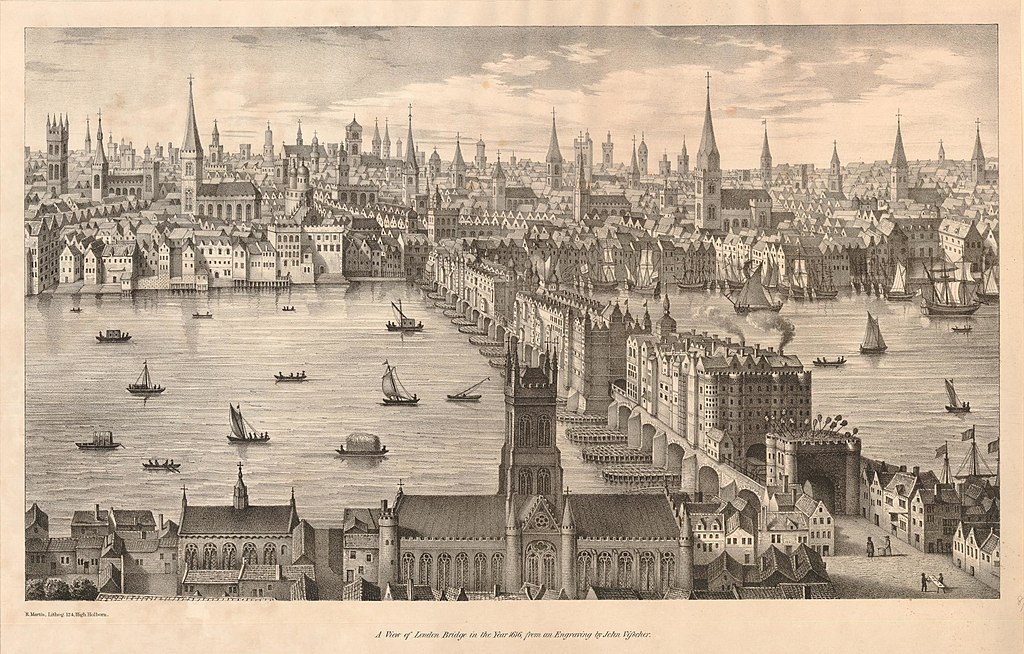 A View of London Bridge in the Year 1616, from an Engraving by John Vischer. Photo Credit: © The Trustees of the British Museum, released as CC BY-NC-SA 4.0.
A View of London Bridge in the Year 1616, from an Engraving by John Vischer. Photo Credit: © The Trustees of the British Museum, released as CC BY-NC-SA 4.0.
Houses on the Old London Bridge
Compared to other European bridges, houses on London Bridge were far larger. This was achieved by building them planted on the bridge and hanging over the river on either side. This in turn posed challenges as each pier was interspersed by a gullet aligned with its corresponding arch. Overhanging gullets were smaller and rested over hammer beams running parallel to the roadway between piers. Houses were propped from below by struts lodged into the piers’ stonework. Until their clearance between 1757 and 1761, houses were built in timber to minimise their weight and circumvent the post-1666 regulations that said all new buildings should be made of stone or brick.
Many houses are recorded as having cellars used as convenience privies, for the storage of coal, lumber, trade goods and, most importantly, beer! Cellars were built either hanging beneath the beams over the gullet or within the stone piers. The latter was always a matter of concern due to tenants tampering with their stonework, with the danger of compromising the piers’ strength. Houses over gullets were vulnerable as the lower parts could be damaged by boats. In 1464, one broke the windows of John Codde’s house, and in 1568, a Dutch ship broke Simon Lowe’s house.
An important feature of the Bridge was its cross buildings. Until the seventeenth century, there were about twelve, roughly one in every other building. Subsequently, they were spread out further with one every other pier. Besides the added living space and extra returns on rent, cross buildings stabilised the houses against wind buffeting. The roadway made its way beneath a series of tunnels, making it arguably London’s first shopping arcade.
All houses had a ground floor shop, making the Bridge one of the busiest shopping tricts in London. The northern section may have been the most prestigious as reflected by higher rents. The Bridge was not ideal for the sale of food and drink, as Bridge House was averse to businesses having ovens, which posed a considerable fire risk. However, records mention the Sun Tavern in 1320 and the Cross Keys alehouse in 1581. Most businesses generally did not sell at the front of the shop, to prevent the piling of shoppers on the road, but welcomed clients inside the premises.
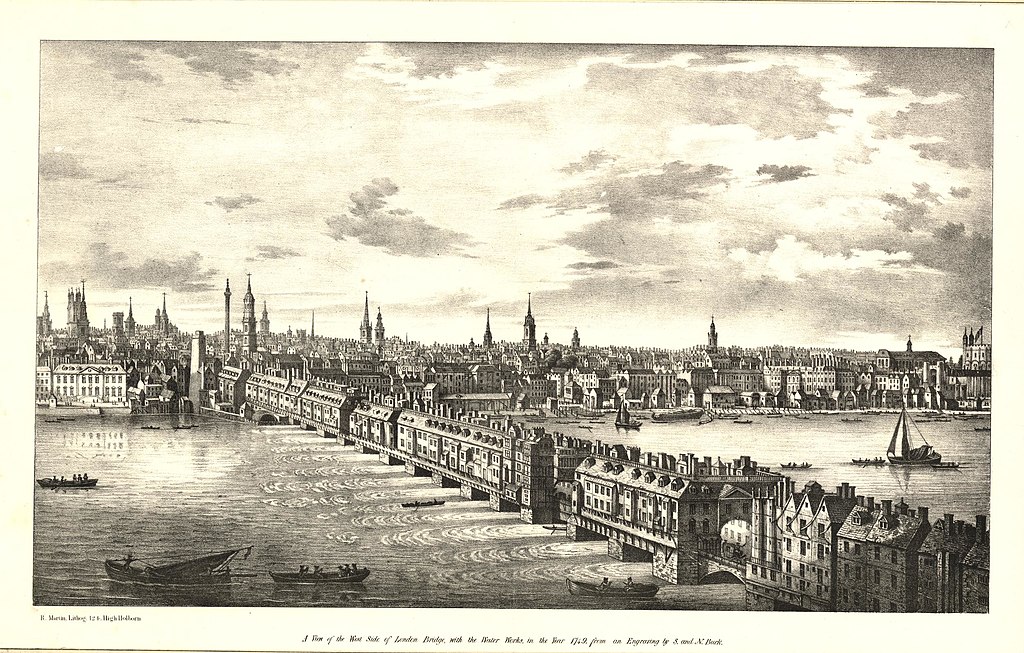 A View of the West Side of London Bridge, with the Water Works, in the Year 1749. Photo Credit: © The Trustees of the British Museum, released as CC BY-NC-SA 4.0.
A View of the West Side of London Bridge, with the Water Works, in the Year 1749. Photo Credit: © The Trustees of the British Museum, released as CC BY-NC-SA 4.0.
Shops on the Old London Bridge
Most shops on the old London Bridge were dedicated to the retail and wholesale of goods, oft-made elsewhere, sometimes in the secondary premises of shop owners. In the fourteenth and fifteenth centuries there was a preponderance of haberdashers, glovers, cutlers, bowyers and fletchers, the latter two selling archer’s bows and arrows. The statutes of this period expected all land freeholders to own knives, bows and arrows and required all able-bodied men to practice archery regularly. With the introduction of firearms in the fifteenth century, archery evolved into a sport, and consequently the trade associated with it declined and shops moved elsewhere.
After 1617, when the apothecaries were allowed to form their company, some of them set up premises on the Bridge. Besides medicinal plants, ground minerals and animal derivatives, they would have traded pigments and other industrial materials used by artists, craftsmen and manufacturers. In the seventeenth century the expanding book trade was reflected in the Bridge’s own bookshops, amongst them The Looking Glass and the Black Boy. Other trades were music shops, dealers in metal goods and more specialised traders like needleworkers, watchmakers, makers of looking glasses (mirrors), mathematical instrument makers and brush-makers.
In the eighteenth century the London Bridge Coffee and Mr Needham’s Coffee House were opened. With the development of the West End, trade on the Bridge declined in the eighteenth century, many shops considered less prestigious than those of its heyday in the sixteenth century..
Famous People Who Lived on the Old London Bridge
Although wealthy, just a handful of Bridge dwellers could be considered prominent figures. Two of these were the sixteenth-century Lord Mayor and clothmaker William Hewitt and his apprentice Edward Osborne. In 1536, Osborne saved Hewitt’s daughter Anne, when she fell from a window into the river. When wealthy suitors requested Anne’s hand, Hewitt, now Master of the Clothworkers’ Company, declared that ‘Osborne saved her and Osborne should enjoy her.’
Osborne later served as Governor of the short-lived Turkey Company, which was superseded by the Levant Company during the reign of Elizabeth I. In the Restoration period, Peter Daniel served twice as Master of the Haberdashers’ Company. In the 1680s, Charles II knighted him for his services, which included controlling the City’s estate. The likeness of Daniel’s parents, William Daniel and Mary, also Bridge dwellers, is seen in their pious-looking seventeenth-century portraits. The Daniels were early Puritans who moved to the village of Clapham, which became a hotbed of non-conformism, leading to the establishment of the Clapham Sect in the eighteenth century.
Traders created a distinctive and healthy community. According to mortality bills, despite the constrictions of its buildings, the Bridge was a fairly salubrious residential area due to its exposure to winds. During the Great Plague of 1665, only two of its inhabitants succumbed to the disease, a negligible number compared with the 15-25% mortality rate estimated in the London area.
Another conspicuous feature which contributed to the Bridge’s healthiness (and one that would have been popular with London’s Blue Badge guides) was its two latrines known as common sieges, one on each end of the Bridge. A surviving record mentions an entrance and separate exit for the northern latrine in 1306, which apparently could cater for 128 users. This is most likely the common siege that ‘fell down into the Thames’ ignominiously killing five men, according to John Stow in 1481. From 1570, only public markets were allowed to have public facilities. By then, both latrines were dismantled as all tenements on the Bridge were required to have their own privies.
One can suppose that those poor souls were memorialised in the Chapel of St Thomas the Martyr. Built upon the largest pier in the middle of the Bridge, it provided a direct link between the Bridge’s foundation and the pilgrimage route from the capital to the shrine of Thomas Becket in Canterbury Cathedral. Not surprisingly, many pilgrims’ badges have been recovered from the river bed around where the middle pier stood. The original chapel was briefly the resting place of Peter Colechurch’s body until badly damaged during the fire that spread across the bridge in 1212-13. In the late fourteenth century, the King’s Master, Mason Henry Yevele, rebuilt the nave with an undercroft, a front gable and a five-sided apse. The chapel could be accessed via a starling by those arriving by boat. This starling featured a well where fish would be trapped at low tide.
When Becket was pronounced a traitor following the Act of Supremacy, the chapel was conveniently rededicated to St Thomas the Apostle. Subsequently, in 1549, following Edward VI’s Reformation policies, it was defaced and converted to a house aptly named Chapel House.
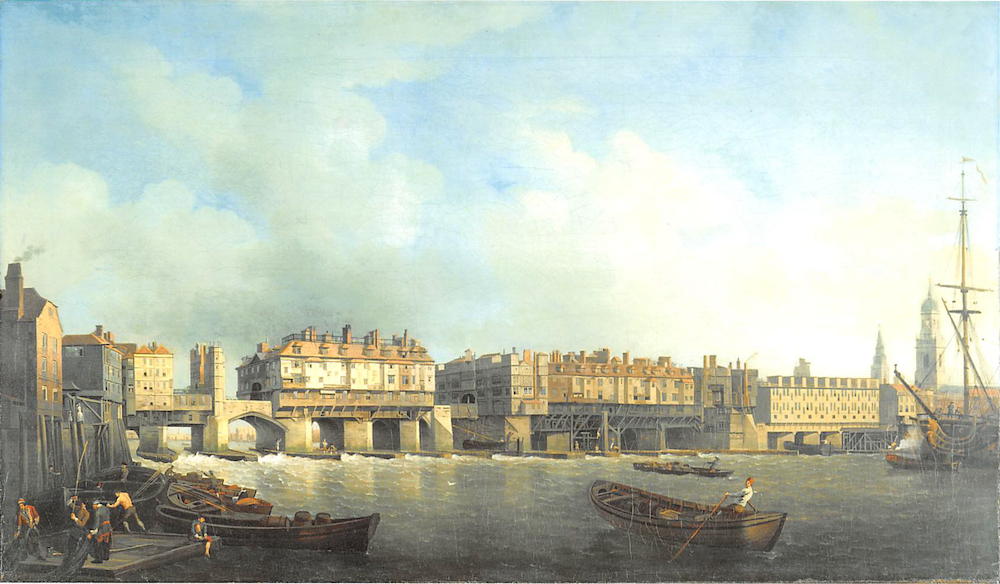 Old London Bridge in 1757, just before the removal of the houses, by Samuel Scott. Photo Credit: © Public Domain via Wikimedia Commons.
Old London Bridge in 1757, just before the removal of the houses, by Samuel Scott. Photo Credit: © Public Domain via Wikimedia Commons.
Nonsuch House on the Old London Bridge
Arguably the most prestigious address on The Bridge was Nonsuch House, its name meaning ‘No other such house.’ It replaced the drawbridge tower in 1577-79 as one of the largest structures on the Bridge and its most distinctive feature was its four corner onion domes and elegant façade painted in bright colours, an early example of Elizabethan Renaissance and the work of Lewis Stockett, who also built an early incarnation of Somerset House on the Strand. Throughout most of its history Nonsuch House was occupied by a haberdashery and a draper’s businesses.
Another admired building was the so called House with Many Windows, built on the south section in 1547-48. This featured four semi-circular towers projecting from its façade which housed spiral staircases topped with battlements rather than onion domes, mirroring the Stone Gate, which stood opposite. The Stone Gate is first mentioned in 1250 and was built as a defensive gateway to the City. During a 1471 rebellion against the restoration of Edward IV, the gate fell, but rebels were stopped at the Drawbridge Tower. During the 1554 Wyatt rebellion against Queen Mary, the Stone Gate defences held up the rebels and it did so again in 1647 when Royalists were prevented from breaching it. After the demolition of the Drawbridge in 1577, the Stone Gate was adorned by the heads of traitors until 1661. Wenceslaus Hollar’s view in the late 1600s is the most evocative depiction of this macabre custom. After 1684 heads of traitors were displayed on Temple Bar.
One industry that flourished on the Bridge was its waterworks. From 1581, they provided a clean supply of water to bridge dwellers. By 1831, five water wheels under four arches on the northern end fed into 54,000 yards of pipe and 3,860 yards of lead, enough water to supply 10,000 people. However, once the bridge was rebuilt, water could no longer flow through at the same rate.
Even without the houses, maintenance of the Bridge continued to be expensive, and navigation beneath it remained treacherous. It looked increasingly rudimentary, and its history inconsequential. However, its legacy lives on in our modern navigational directions and the amusement it elicits. It is believed that when the road was widened in the 1670s, wheeled traffic was required to be driven on a specific side of the road according to the direction of travel. This was a keep-right rule and was enforced by two beadles at either end. This followed the practice of drivers of teams walking to the left of the horses, whip in hand, protecting the team from traffic in the opposite direction to their left. It is not quite clear why a switch of sides occurred in 1722, but it has been suggested that this favoured drivers seated on the right of their carriages. From this position, they could judge a safe distance from incoming traffic. Thus Blue Badge Tourist Guides often tell clients from the USA or Europe, ‘you may drive on the right side of the road, but we drive on the correct side.’
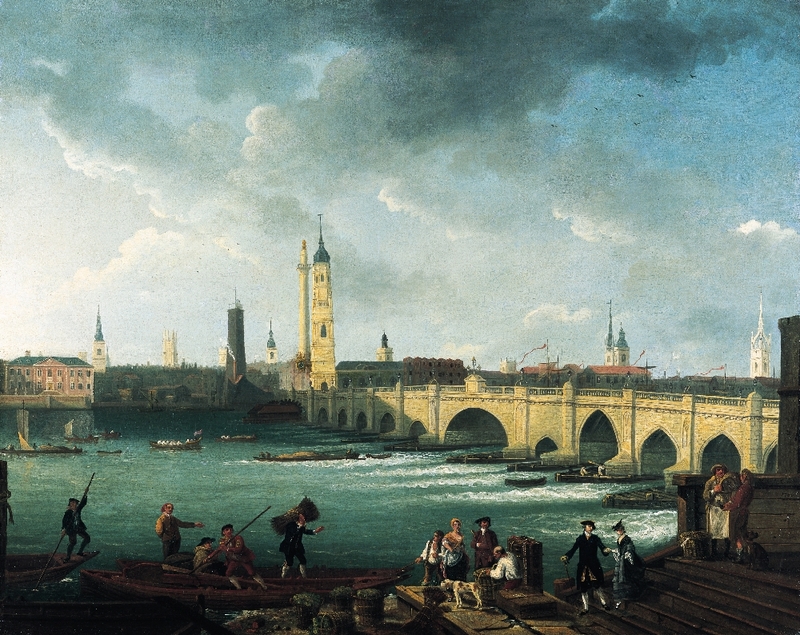 London Bridge from Pepper Alley Stairs by Herbert Pugh, showing the appearance of London Bridge after 1762, with the new Great Arch at the centre. Photo Credit: © Public Domain via Wikimedia Commons.
London Bridge from Pepper Alley Stairs by Herbert Pugh, showing the appearance of London Bridge after 1762, with the new Great Arch at the centre. Photo Credit: © Public Domain via Wikimedia Commons.



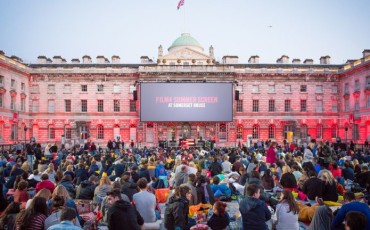
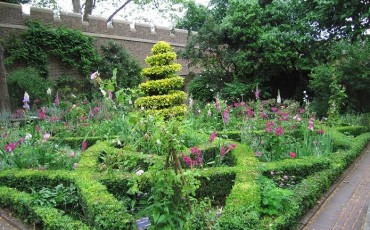


Leave a Reply